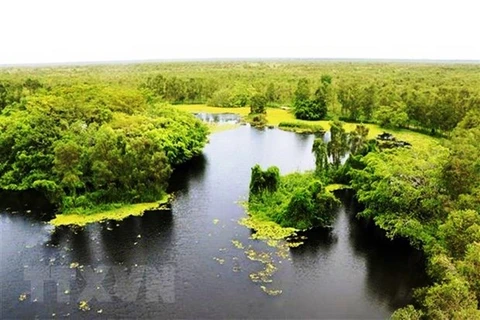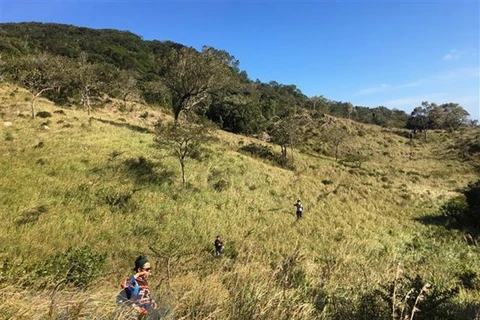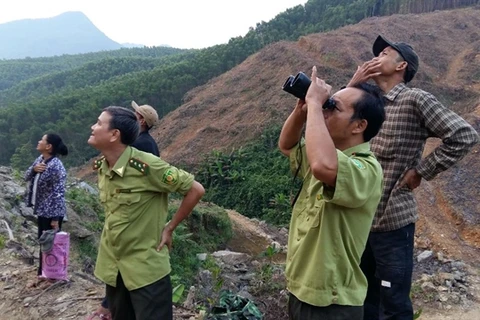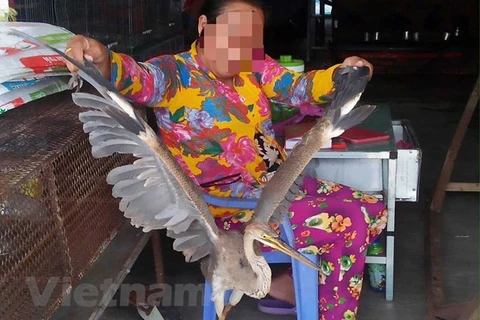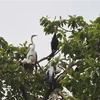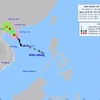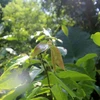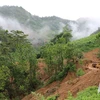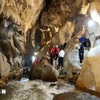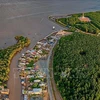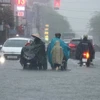Hanoi (VNA) – Covering about 12 million hectares in all ecological zones, wetlands in Vietnam provide habitat for thousands of species and greatly help with ecological balance while providing sources of livelihoods for millions of people.
However, wetlands are being hit by increasing impact of human activities and climate change. A large number of such areas have disappeared or shrunk under the growing pressure of exploitation by humans.
Facing that fact, the Ministry of Natural Resources and Environment has built and submitted for approval a national action plan on the conservation and sustainable use of wetlands for 2020 – 2030, with a view to protecting the “cradle” of biodiversity.
Many wetlands shrinking
Hoang Thi Thanh Nhan, Deputy Director of the department of nature and biodiversity conservation at the Vietnam Environment Administration, said wetlands are critically important to life as they provide important ecosystem services, including supplying resources for many economic sectors like fisheries, agriculture and tourism, to serve prosperous development of each country.
Wetlands are also able to store carbon and regulate water sources and climate while helping with the deposition of sediments and taking an active part in the nutrient cycle in the global ecosystem. They also serve as an important “cradle” of biodiversity and mitigate impacts of storms, especially mangrove ecosystems in coastal areas.
Statistics show that wetlands provided food and aquatic products worth more than 10 billion USD for domestic consumption and export in 2017. About 20 million people in Vietnam have their income wholly or partially generated by aquatic resources, and they are exploiting and using more than 300 sea species and 50 freshwater species.
In recent years, wetlands have been strongly capitalised on to serve tourism development. Such wetland areas as Cat Ba, Con Dao, Phong Nha – Ke Bang, Can Gio, Ba Be, and Tram Chim have attracted a large number of both domestic and foreign visitors.
[Biodiversity conservation plan to be built]
Additionally, wetlands boast cultural, social and historical values. They are the origin of the wet rice civilisation, which is closely associated with the culture and spiritual life of Vietnamese people.
Notably, wetlands also feature scientific and education values which give humans a better understanding of natural systems, thus helping to protect and rehabilitate the environment, conserve and sensibly use natural resources for the sake of sustainable development.
Therefore, the conservation and sustainable development of wetlands are among the priorities in the Party and State’s policies.
Despite this, Nhan noted, wetlands in Vietnam are increasingly affected by human activities and climate change. It is a fact that many wetland areas have disappeared or shrunk recently under the pressure of growing exploitation and use of natural resources in wetlands.
Taking an example, she said sea and lake encroachment to develop industrial parks, residential areas and tourism infrastructure, as well as the blocking of water flows to build hydropower plants and reservoirs, could lead to rapid degradation and narrowing of wetlands.
Besides, environmental pollution caused by industrial parks or excessive use of fertilizers and chemicals have also led to serious degradation of many rivers and inshore areas, such as the marine pollution triggered by waste discharge of the Formosa Ha Tinh company in the central region.
Overexploitation has also negatively influenced natural resources and biodiversity of wetlands. Many aquatic species with high economic value like Anhvu carp (Semilabeo notabilis), bagrid catfish, and lobsters have witnessed a strong decline in their populations.
Recovering degraded land, expanding Ramsar sites
Facing that fact, the Government issued Decree 66/2019/ND-CP on July 29, 2019, that regulates the conservation and sustainable use of wetlands.
The Ministry of Natural Resources and Environment has also built and submitted for approval a national action plan on the conservation and sustainable use of wetlands for 2020 – 2030.
This action plan aims to protect wetlands in Vietnam via promoting the development of ecological, cultural and socio-economic values of wetlands nationwide, while engaging relevant parties, communities and the private sector in the management and sustainable use of wetland ecosystem services so as to realise the country’s international commitments related to wetland management and biodiversity, thereby helping with poverty reduction, socio-economic development, climate change response, and environmental protection.
According to this draft plan, by 2025, Vietnam will put in place a full system of policies, laws, management and coordination mechanisms pertaining to wetland conservation and sustainable use. It will also have completed the stocktaking and classification of wetlands and integrated the wetland database into the national database on biodiversity.
The country will also strive to recover at least 10 percent of the area of important wetlands showing signs of degradation, set up five wetland reserves, successfully seek Ramsar (wetland of international importance) title for three sites, and carry out models that engage relevant parties in the management and sensible use of natural resources and ecosystem services of important wetlands.
Besides, efforts will be made to raise public awareness of and support for the conservation and sustainable use of wetlands nationwide, expand the network of Ramsar sites, and ensure their effective operation.
[Exploring nine Ramsar sites of Vietnam]
Under this national action plan, by 2030, the country will ensure that all of its important wetlands are managed, conserved and used sensibly, 25 percent of the area of important wetlands recovered, at least 10 wetland reserves set up, and at least five more sites given the Ramsar title.
There are nine Ramsar sites in Vietnam at present, namely Xuan Thuy National Park, Bau Sau Wetlands and Seasonal Floodplains of Cat Tien National Park, Ba Be National Park, Tram Chim National Park, Mui Ca Mau (Ca Mau Cape) National Park, Con Dao National Park, Lang Sen Wetland Reserve, U Minh Thuong National Park, and Van Long Wetland Nature Reserve./.
| According to the Ministry of Natural Resources and Environment, Vietnam is home to 26 types of wetlands, including marine, coastal, inland and artificial wetlands, which harbour rich biodiversity with 1,028 fish species, 848 bird species, 800 invertebrates in freshwater ecosystems, and over 11,000 species in marine and coastal wetland ecosystems. |


